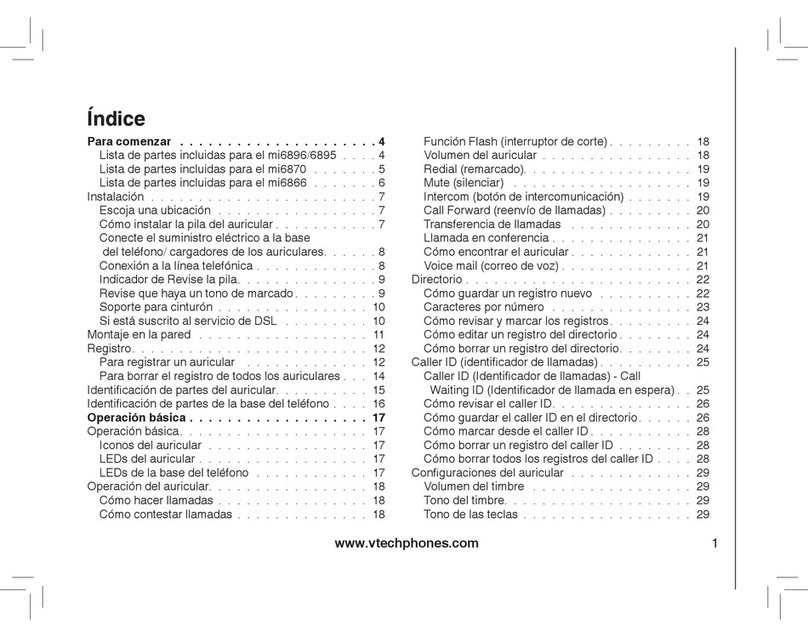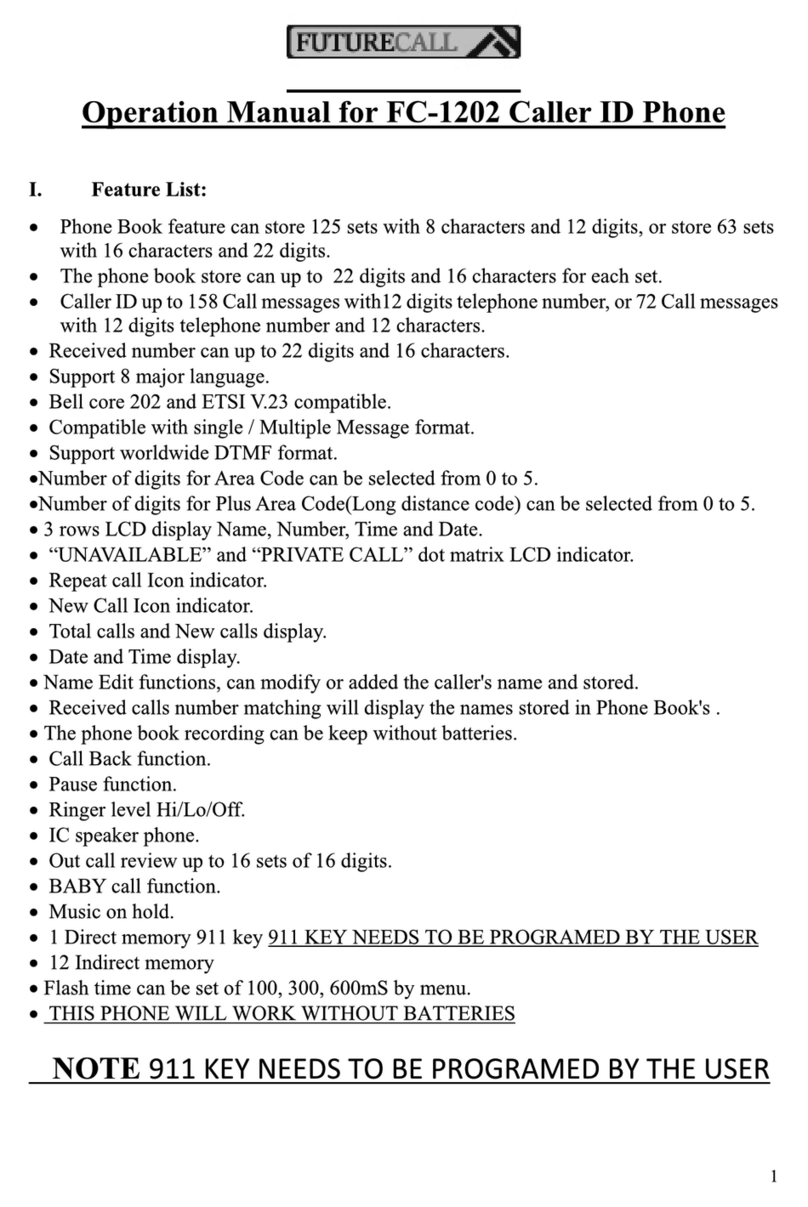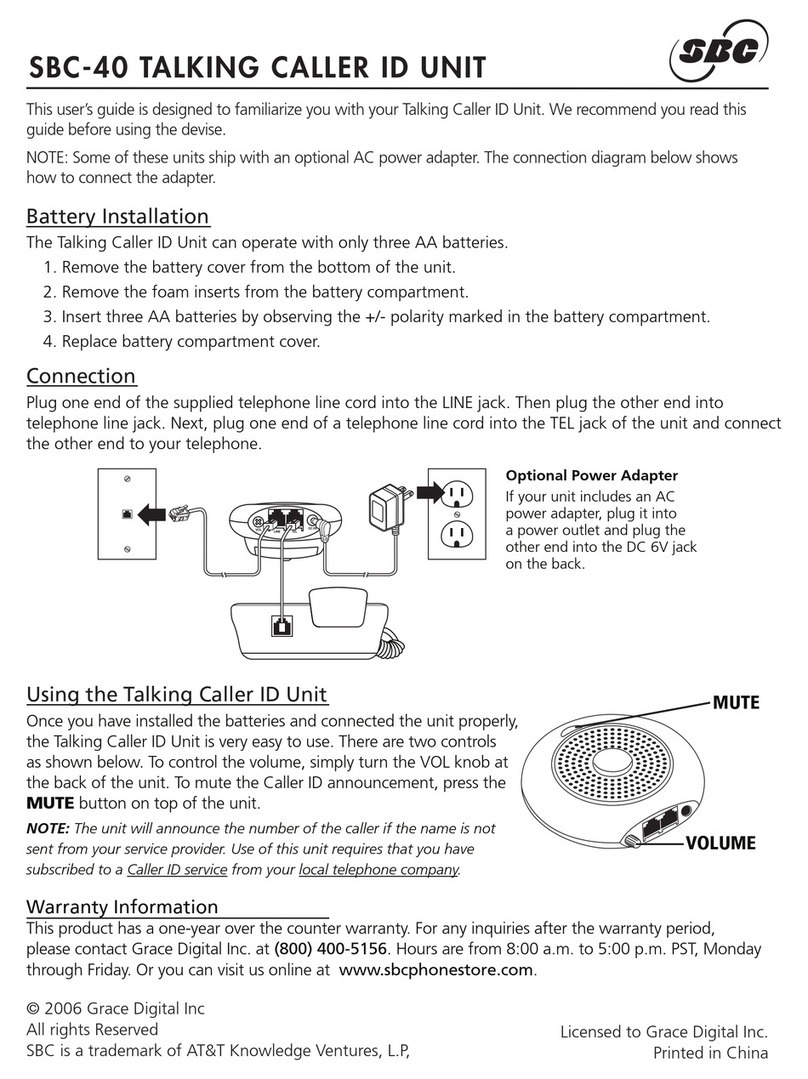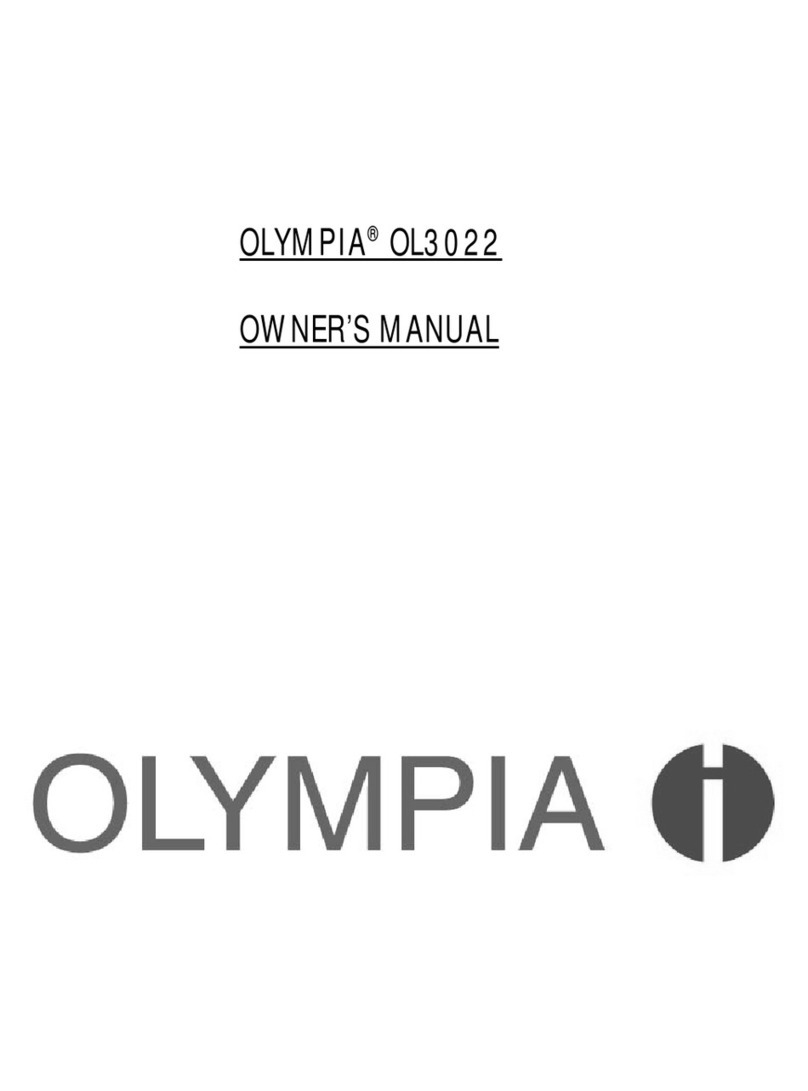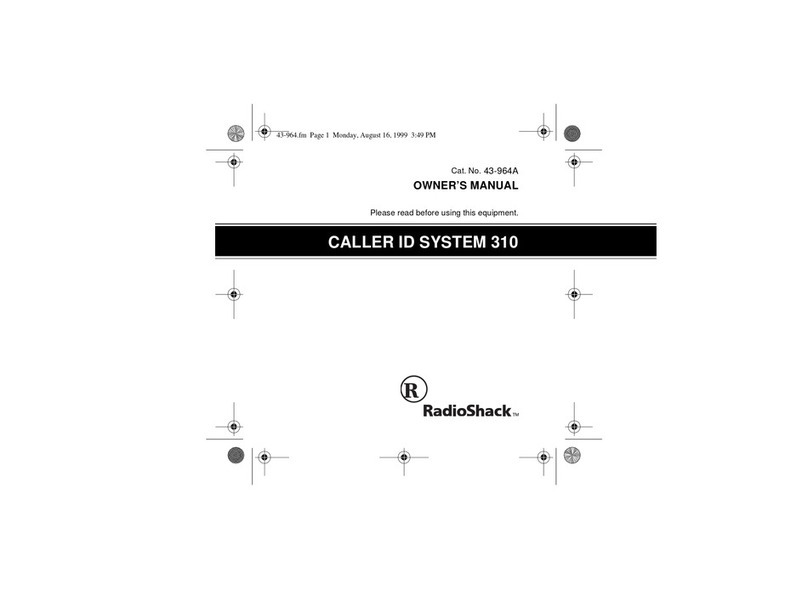Black Box TE120A User manual

CUSTOMER
SUPPORT
INFORMATION
Order toll-free in the U.S.: Call 877-877-BBOX (outside U.S. call 724-746-5500)
FREE technical support 24 hours a day, 7 days a week: Call 724-746-5500 or fax 724-746-0746
Mailing address: Black Box Corporation, 1000 Park Drive, Lawrence, PA 15055-1018
OCTOBER 2001
TE120A
TE121A
4- and 8-Line Caller ID

1
FEDERAL COMMUNICATIONS COMMISSION AND INDUSTRY CANADA
RADIO-FREQUENCY INTERFERENCE STATEMENTS
This equipment generates, uses, and can radiate radio-frequency energy and if not
installed and used properly, that is, in strict accordance with the manufacturer’s
instructions, may cause interference to radio communication. It has been tested
and found to comply with the limits for a Class A computing device in accordance
with the specifications in Subpart J of Part 15 of FCC rules, which are designed to
provide reasonable protection against such interference when the equipment is
operated in a commercial environment. Operation of this equipment in a
residential area is likely to cause interference, in which case the user at his own
expense will be required to take whatever measures may be necessary to correct the
interference.
Changes or modifications not expressly approved by the party responsible for
compliance could void the user’s authority to operate the equipment.
This digital apparatus does not exceed the Class A limits for radio noise emission from digital
apparatus set out in the Radio Interference Regulation of Industry Canada.
Le présent appareil numérique n’émet pas de bruits radioélectriques dépassant les limites
applicables aux appareils numériques de la classe A prescrites dans le Règlement sur le
brouillage radioélectrique publié par Industrie Canada.
TRADEMARKS USED IN THIS MANUAL
BLACK BOX and the logo are registered trademarks of Black Box
Corporation.
Any other trademarks mentioned in this manual are acknowledged to be the property of the
trademark owners.
FCC/IC RFI STATEMENTS, TRADEMARKS

2
4- AND 8-LINE CALLER ID
FCC REQUIREMENTS FOR TELEPHONE-LINE EQUIPMENT
1. The Federal Communications Commission (FCC) has established rules which
permit this device to be directly connected to the telephone network with
standardized jacks. This device must not be used on coin lines. Its use on
party lines is subject to state tariffs; for more information, contact your state’s
public-utility commission or corporation commission.
2. If this device is malfunctioning, it might also be causing harm to the
telephone network; this device should be disconnected until the source of the
problem can be determined and until the repair has been made. If this is not
done, the telephone company may temporarily disconnect service. If possible,
they will notify you of this in advance. But if advance notice isn’t practical, you
will be notified as soon as possible. You will be advised of your right to file a
complaint with the FCC.
3. If you have problems with your telephone equipment after installing this
device, disconnect this device from the line to see if it is causing the problem
If it is, contact Black Box or an authorized agent.
4. The telephone company may make changes in its technical operations and
procedures. If any such changes affect the compatibility or use of this device,
the telephone company is required to give adequate notice of the changes.
5. If the telephone company requests information on what equipment is
connected to their lines, inform them of:
a. The telephone number that this device is connected to.
b. The name and part number of this device.
c. The ringer equivalence number (REN): 0.0 B.
d. The service order code (SOC): 9.0F.
e. The facility interface code (FIC): 02LS2, 02GS2.
f. The USOC jack required: RJ-14C for TE120A, RJ-11C for TE121A.
g. The FCC registration number.
Items (c) and (g) can be found on the unit’s FCC label. The ringer
equivalence number (REN) is used to determine how many devices can be
connected to your telephone line. In most areas, the sum of the RENs of all
devices on any one line should not exceed five (5.0). If too many devices are
attached, they might not ring properly.
6. In the event of an equipment malfunction, all repairs should be performed by
Black Box or an authorized agent. It is the responsibility of users requiring
service to report the need for service to Black Box or to an authorized agent.

3
CERTIFICATION NOTICE FOR TELEPHONE EQUIPMENT USED IN CANADA
The Industry Canada label identifies certified equipment. This certification means
that the equipment meets certain telecommunications-network protective,
operation, and safety requirements. Industry Canada does not guarantee the
equipment will operate to the user’s satisfaction.
Before installing this equipment, users should ensure that it is permissible to be
connected to the facilities of the local telecommunications company. The
equipment must also be installed using an acceptable method of connection. In
some cases, the company’s inside wiring associated with a single-line individual
service may be extended by means of a certified connector assembly (extension
cord). The customer should be aware that compliance with the above conditions
might not prevent degradation of service in some situations.
Repairs to certified equipment should be made by an authorized Canadian
maintenance facility—in this case, Black Box. Any repairs or alterations made by
the user to this equipment, or equipment malfunctions, may give the
telecommunications company cause to request the user to disconnect the
equipment.
Users should ensure for their own protection that the electrical ground
connections of the power utility, telephone lines, and internal metallic water-pipe
system, if present, are connected together. This precaution may be particularly
important in rural areas.
CAUTION!
Users should not attempt to make such connections themselves, but
should contact the appropriate electric inspection authority, or
electrician, as appropriate.
The LOAD NUMBER (LN) assigned to each terminal device denotes the
percentage of the total load to be connected to a telephone loop which is used by
the device, to prevent overloading. The termination on a loop may consist of any
combination of devices, subject only to the requirement that the total of the load
numbers of all the devices does not exceed 100.
CANADIAN TELEPHONE-EQUIPMENT STATEMENT

4
4- AND 8-LINE CALLER ID
NORMAS OFICIALES MEXICANAS (NOM)
ELECTRICAL SAFETY STATEMENT
INSTRUCCIONES DE SEGURIDAD
1. Todas las instrucciones de seguridad y operación deberán ser leídas antes de
que el aparato eléctrico sea operado.
2. Las instrucciones de seguridad y operación deberán ser guardadas para
referencia futura.
3. Todas las advertencias en el aparato eléctrico y en sus instrucciones de
operación deben ser respetadas.
4. Todas las instrucciones de operación y uso deben ser seguidas.
5. El aparato eléctrico no deberá ser usado cerca del agua—por ejemplo, cerca
de la tina de baño, lavabo, sótano mojado o cerca de una alberca, etc.
6. El aparato eléctrico debe ser usado únicamente con carritos o pedestales que
sean recomendados por el fabricante.
7. El aparato eléctrico debe ser montado a la pared o al techo sólo como sea
recomendado por el fabricante.
8. Servicio—El usuario no debe intentar dar servicio al equipo eléctrico más allá
a lo descrito en las instrucciones de operación. Todo otro servicio deberá ser
referido a personal de servicio calificado.
9. El aparato eléctrico debe ser situado de tal manera que su posición no
interfiera su uso. La colocación del aparato eléctrico sobre una cama, sofá,
alfombra o superficie similar puede bloquea la ventilación, no se debe colocar
en libreros o gabinetes que impidan el flujo de aire por los orificios de
ventilación.
10. El equipo eléctrico deber ser situado fuera del alcance de fuentes de calor
como radiadores, registros de calor, estufas u otros aparatos (incluyendo
amplificadores) que producen calor.
11. El aparato eléctrico deberá ser connectado a una fuente de poder sólo del
tipo descrito en el instructivo de operación, o como se indique en el aparato.

5
NOM STATEMENT
12. Precaución debe ser tomada de tal manera que la tierra fisica y la polarización
del equipo no sea eliminada.
13. Los cables de la fuente de poder deben ser guiados de tal manera que no
sean pisados ni pellizcados por objetos colocados sobre o contra ellos,
poniendo particular atención a los contactos y receptáculos donde salen del
aparato.
14. El equipo eléctrico debe ser limpiado únicamente de acuerdo a las
recomendaciones del fabricante.
15. En caso de existir, una antena externa deberá ser localizada lejos de las lineas
de energia.
16. El cable de corriente deberá ser desconectado del cuando el equipo no sea
usado por un largo periodo de tiempo.
17. Cuidado debe ser tomado de tal manera que objectos liquidos no sean
derramados sobre la cubierta u orificios de ventilación.
18. Servicio por personal calificado deberá ser provisto cuando:
A: El cable de poder o el contacto ha sido dañado; u
B: Objectos han caído o líquido ha sido derramado dentro del aparato; o
C: El aparato ha sido expuesto a la lluvia; o
D: El aparato parece no operar normalmente o muestra un cambio en su
desempeño; o
E: El aparato ha sido tirado o su cubierta ha sido dañada.

6
4- AND 8-LINE CALLER ID
Contents
Chapter Page
1. Specifications ............................................................................................. 7
2. Introduction ............................................................................................... 9
2.1 Overview .............................................................................................. 9
2.2 How the Caller ID Units Work ......................................................... 11
2.3 Connectors and Pinouts ................................................................... 16
2.4 The Complete Package ..................................................................... 17
3. Configuration ........................................................................................... 18
3.1 DIP Switch S1 (TE121A Only) ......................................................... 18
3.2 DIP Switch S2 .................................................................................... 19
4. Installation ................................................................................................ 20
5. Operation ................................................................................................. 23
5.1 LEDs ................................................................................................... 23
5.2 How the Unit Handles Caller ID Information ................................ 23
5.3 Message Format ................................................................................. 24
6. Troubleshooting ...................................................................................... 25
6.1 Testing ............................................................................................... 25
6.2 Things to Try ..................................................................................... 25
6.3 Calling Black Box .............................................................................. 26
6.4 Shipping and Packaging ................................................................... 26
Appendix: Wallmount Template for 4-Line Unit ......................................... 27

7
CHAPTER 1: Specifications
1. Specifications
Compliance:
EMI/RFI: FCC Part 15 Subpart J Class A, IC Class/classe A;
Phone-system compatibility: FCC Part 68 (registration
number 1LJUSA-18773-ND-N);
Fire/electrical safety:
Both units: ETL;
TE121A only: CSA
Interfaces: To the telephone network: Modular telco;
To the DTE and for daisychaining: Proprietary variant of
EIA/TIA RS-232 serial, pinned on DB9 according to
TIA-574
Protocol: RS-232: Asynchronous
Data Rate: RS-232: 1200, 2400, 4800, or 9600 bps (user-selectable)
Data Format: RS-232: 7 or 8 data bits and even, odd, or no parity (user-
selectable); 1 stop bit (fixed)
Receive Level: –10 to –33 dBm
Maximum
Distance: RS-232 cabling from Caller ID unit to DTE or to next
daisychained unit: 50 ft. (15.2 m)
User Controls: (2) Front-mounted 8-position DIP switches for signal
handling, data format, data rate, and unit number
Indicators: (2) Front-mounted LEDs for power and data activity
Connectors: All rear-mounted;
(1) DB9 female for output to daisychain or DTE;
(1) DB9 male for input from daisychain;
TE120A: (2) RJ-14C female for dual-line phone-network
connections;
TE121A: (8) RJ-11C female for single-line phone-network
connections
Temperature
Tolerance: Operating: 10 to 120˚F (–12 to +49˚C);
Storage: 0 to 150˚F (–18 to +66˚C)

8
4- AND 8-LINE CALLER ID
Humidity
Tolerance: 20 to 90% noncondensing
Enclosure: High-impact plastic
Power: From utility-power (mains) outlet, through external
power-supply transformer:
TE120A:
Input: 120 VAC, 60 Hz, at up to 300 mA;
Output: +23 VAC at 160 mA nominal;
TE121A:
Input: 120 VAC, 60 Hz, at up to 120 mA;
Output:
+5 VDC at 380 mA;
+12 VDC at 180 mA;
–12 VDC at 180 mA
Size: TE120A: 1.9"H x 4.4"W x 7.5"D (4.8 x 11.2 x 19.1 cm);
TE121A: 1.9"H x 8.3"W x 9"D (4.8 x 21.1 x 22.9 cm)
Weight: TE120A:
Net:
Unit: 1 lb. (0.5 kg);
Power supply: 0.8 lb. (0.4 kg);
Shipping: 3 lb. (1.4 kg);
TE121A:
Net:
Unit: 1.7 lb. (0.8 kg);
Power supply: 1 lb. (0.5 kg)
Shipping: 4 lb. (1.8 lb.)

9
CHAPTER 2: Introduction
2. Introduction
2.1 Overview
The 4- and 8-Line Caller ID units (product codes TE120A and TE121A
respectively) receive Caller ID (identification) data from the telephone company
and send the data, in ASCII RS-232C format, to a printer, terminal, computer, or
other DTE (data terminal equipment). As an interface, the Caller ID unit only
receives, converts, and then resends the the Caller ID information to a DTE device
(not included). Any printing or displaying of the data is done by the DTE.
The Caller ID unit is compatible with most key systems and PBXes, and is also
compatible with most of the current C.O.-based message-waiting services. This
device is single- and multiple-message compatible. Caller ID services are currently
being offered by many telephone companies as a subscribed service (check for
service availability).
The Caller ID units have one or two 8-position DIP switches on their front panels
(shown in Figures 2-1 and 2-2 on the next page). These switches control the data
rate, data bits, parity, voltage, and line or port specifications for configuring the
unit to work with the DTE device.
The telephone-line ports are located on the rear panels of the Caller ID units
(also shown in Figures 2-1 and 2-2 on the next page). You’ll use regular modular
phone cable to attach these RJ-14C (TE120A) or RJ-11C (TE121A) input jacks to
the incoming telephone lines from the central office. You’ll be using line splitters
or cross-connects to attach the Caller ID units “in parallel” with the telephone
devices associated with those lines (see Chapter 4).
The Caller ID unit’s power-supply connector is also located on its rear panel.
The power supply is an external AC-power adapter requiring a common AC outlet.
On the rear panel there are also two connectors, RS-232 IN and RS-232 OUT,
which you can use to daisychain (interconnect) as many as eight Caller ID units in
order to monitor up to 32 or 64 lines or ports with a single RS-232 connection to a
DTE. (32 will be the maximum number of lines if you use any 4-port units; 64 will
be the maximum if you use only 8-port units.)

10
4- AND 8-LINE CALLER ID
Figure 2-1. Front (shown at top) and rear (shown at bottom) panels of the
4-Line Caller ID (TE120A).
Figure 2-2. Front (shown at top) and rear (shown at bottom) panels of the
8-Line Caller ID (TE121A).

11
CHAPTER 2: Introduction
2.2 How the Caller ID Units Work
The Caller ID units receive calls on any of their modular phone-line ports, which
you’ll connect directly to the incoming central-office telephone lines in parallel
with the telephone, key system, or PBX. After detecting the Caller ID data from the
local telephone company, the Caller ID unit stamps this information with the port
number, converts it into ASCII, and transmits it from its RS-232 OUT port to an
attached PC, printer, or other RS-232 DTE. (The Caller ID unit will only indicate
that data has been received if a DTE is connected to the RS-232 OUT port. It will
light its “DATA” LED to indicate that it’s sending data through its RS-232 OUT
port.) The flow of the data in systems with a single Caller ID unit is shown in
Figures 2-3 and 2-4 on the next two pages; the data flow in systems with multiple
daisychained Caller ID units is shown in Figures 2-5 and 2-6 on the pages that
follow.
What happens to the data after the Caller ID unit transmits it to the DTE is up to
you. You could buy or write a software program to process it (this is often done in
conjunction with a database). But any serial printer, terminal, or PC running a
terminal emulator should be able to accept the data without requiring extra
hardware or software if all you need to do is monitor the data as it’s printed or
appears on screen.
(text continues on page 16)

12
4- AND 8-LINE CALLER ID
Figure 2-3. Signal flow with a 4-Line Caller ID (TE120A).

13
CHAPTER 2: Introduction
Figure 2-4. Signal flow with an 8-Line Caller ID (TE121A).

14
4- AND 8-LINE CALLER ID
Figure 2-5. Signal flow with multiple 4-Line Caller IDs (TE120A).

15
CHAPTER 2: Introduction
Figure 2-6. Signal flow with multiple 8-Line Caller IDs (TE121A).

16
4- AND 8-LINE CALLER ID
(text continued from page 11)
2.3 Connectors and Pinouts
There are several connectors on the Caller ID units. Each 4-Line unit (TE120A)
has two dual-line RJ-14C female telephone-line ports and a barrel-type power inlet.
Each 8-Line unit has eight single-line RJ-11C female telephone-line ports and a
5-pin DIN female power inlet. The RJ-14C and RJ-11C pinouts look like this:
Pin RJ-14C (TE120A) Signal RJ-11C (TE121A) Signal
1, 6 [No connection] [No connection]
2 2nd line (2 or 4) tip [No connection]
3 1st line (1 or 3) tip Tip
4 1st line (1 or 3) ring Ring
5 2nd line (2 or 4) ring [No connection]
Both 4- and 8-Line units have two RS-232 ports whose data rate, parity, data bits,
and flow control are all user-selectable (see Section 3.2). The RS-232 OUT port is a
DB9 female connector pinned as an RS-232 DCE port. (This means that it actually
transmits data on its Receive Data lead, as a modem would.) It’s designed to be
connected to printers, terminals, PCs running terminal emulators, and other
DTEs. (In daisychained applications, it can be connected to the RS-232 IN port of
the next Caller ID unit in the chain.) The RS-232 OUT port is pinned this way:
Pin Signal Direction
1 Carrier Detect (CD) Out (to other device)
2 Receive Data (RD) Out (to other device)
5 Signal Ground (SGND) N/A
6 Data Set Ready (DSR) Out (to other device)
7 Request to Send (RTS) In (from other device)
8 Clear to Send (CTS) Out (to other device)
9 Busy Out (to other Caller ID unit)
NOTES
Pin 7, RTS, must be pulled active (high) in order for the Caller ID unit to
turn on its DATA LED when it receives Caller ID information from a
telephone line.
Pin 9, Busy, is a proprietary signal used primarily for communication
between daisychained Caller ID units, although it can be connected to
Pin 22, Ring Indicator (RI), on a DTE with a DB25 serial port, as shown in
Table 4-1 at the end of Chapter 4.

17
CHAPTER 2: Introduction
The RS-232 IN port is a DB9 male connector pinned as an RS-232 DTE port. It’s
only used when multiple Caller ID units are daisychained together; it receives
information from units farther along in the chain. The RS-232 IN port is pinned
this way (see the Note on the previous page about the Busy signal on Pin 9):
Pin Signal Direction
2 Receive Data (RD) In (from other Caller ID unit)
5 Signal Ground (SGND) N/A
7 Request to Send (RTS) Out (to other Caller ID unit)
8 Clear to Send (CTS) In (from other Caller ID unit)
9 Busy In (from other Caller ID unit)
2.4 The Complete Package
Each 4-Line Caller ID comes with:
• (2) Condenser cables with two RJ-11C plugs at one end and one RJ-14C plug at
the other end.
• Power supply.
• This manual.
Each 8-Line Caller ID comes with:
• (1) Standard phone cable with RJ-11C plugs at both ends.
• Power supply.
• This manual.
If anything is missing or damaged, call Black Box. Also notify the shipping carrier if
any damage appears to have occurred during shipping.

18
4- AND 8-LINE CALLER ID
3. Configuration
You’ll configure your Caller ID units for your application using their front-
mounted 8-position configuration DIP switches. Both models have a switch labeled
S2 that controls RS-232 characteristics and unit number. The 8-Line model has an
additional switch labeled S1 for signal handling.
3.1 DIP Switch S1 (TE121A Only)
DIP switch S1 controls the voltage and behavior of three of the pins/signals on the
RS-232 OUT port (see Section 2.3) of the 8-Line Caller ID (TE121A
), so that it will
be compatible with your other RS-232 devices. (All of the
possible settings of S1’s
switch positions that aren’t listed below are invalid—do not use unlisted settings,
because they could disable or damage attached equipment.)
Positions 1 and 2 govern how Pin 1, Carrier Detect (CD), is handled:
•1 OFF, 2 OFF: Pin 1 output is disabled (factory-default setting).
•1 ON, 2 OFF: Causes continuous +12 VDC output on Pin 1.
•1 OFF, 2 ON: Causes continuous –12 VDC output on Pin 1.
Positions 3, 4, and 5 govern how Pin 6, Data Set Ready (DSR), is handled:
•3 OFF, 4 OFF, 5 OFF: Pin 6 output is disabled (factory-default setting).
•3 ON, 4 OFF, 5 OFF: Causes continuous +12 VDC output on Pin 6.
•3 OFF, 4 ON, 5 OFF: Causes Pin 6 (DSR) output to follow Pin 8 (CTS) output.
•3 OFF, 4 OFF, 5 ON: Causes continuous –12 VDC output on Pin 6.
Positions 6, 7, and 8 govern how Pin 9, the proprietary Busy signal, is handled:
•6 OFF, 7 OFF, 8 OFF: Pin 9 output is disabled (factory-default setting).
•6 ON, 7 OFF, 8 OFF: Causes continuous +12 VDC output on Pin 9.
•6 OFF, 7 ON, 8 OFF: Causes Pin 9 output to follow Pin 9 input from the
RS-232 IN port.
•6 OFF, 7 OFF, 8 ON: Causes continuous –12 VDC output on Pin 9.

19
CHAPTER 3: Configuration
3.2 DIP Switch S2
DIP switch S2 controls both the unit number (if you’ll be daisychaining Caller ID
units) and the serial communication characteristics of the RS-232 OUT and RS-232
IN ports (see Section 2.3) and the unit number (if you will be daisychaining Caller
ID units).
(All of the
possible settings of S2’s switch positions that aren’t listed
below are invalid—do not use unlisted settings, because they could disable or
damage attached equipment.)
Use positions 1 and 2 to set the data rate of the RS-232 OUT port:
•1 OFF, 2 OFF: 1200 bps.
•1 ON, 2 OFF: 2400 bps.
•1 OFF, 2 ON: 4800 bps.
•1 ON, 2 ON: 9600 bps (factory-default setting).
Use position 3 to set the data bits of the RS-232 OUT port:
•3 OFF: 7 data bits.
•3 ON: 8 data bits (factory-default setting).
Use positions 4 and 5 to set the parity of the RS-232 OUT port:
•4 OFF, 5 OFF: No parity (factory-default setting).
•4 ON, 5 OFF: Odd parity.
•4 OFF, 5 ON or 4 ON, 5 ON: Even parity.
Use positions 6, 7, and 8 to set the unit number: “1” for a single unit or “1,” “2,”
etc., for daisychained units successively closer to the DTE. For example, if you have
three 4-Line units in a daisychain, you must set the one farthest from the DTE as
unit #1, the one in the middle as unit #2, and the one attached to the DTE as #3.
(However, if you’ll have 4-Line and 8-Line units in the same daisychain, see the
Note at the start of Chapter 4.) The possible settings are:
•6 OFF, 7 OFF, 8 OFF: Unit is #1 (factory-default setting).
•6 ON, 7 OFF, 8 OFF: Unit is #2.
•6 OFF, 7 ON, 8 OFF: Unit is #3.
.• 6 ON, 7 ON, 8 OFF: Unit is #4.
•6 OFF, 7 OFF, 8 ON: Unit is #5.
•6 ON, 7 OFF, 8 ON: Unit is #6.
•6 OFF, 7 ON 8 ON: Unit is #7.
•6 ON, 7 ON, 8 ON: Unit is #8
This manual suits for next models
1
Table of contents
